|
If you didn’t know beforehand, have a guess how long it would take you to realise that the 1973 La rose de fer (The Iron Rose) was the work of French writer-director Jean Rollin, If you picked five seconds or less, you win a vampire’s kiss. That’s because it opens on a static wide shot of a seashore, and you won’t need to have seen many of Rollin’s films to instantly recognise it as his beloved Plage de Dieppe beach, which over the years became as much a signature on Jean Rollin films as Alfred Hitchcock’s cameo appearances were on his. Standing on the beach, seemingly lost in her thoughts, is a young woman (Françoise Pascal) who becomes intrigued by an object that she sees and retrieves from the surf. It turns out to be an ornate rose that has been cast in iron, the sort of decoration you might find on a wrought iron gate and that we can presume has broken off and been claimed by the sea. Although initially entranced by the rose, she eventually throws it back into the surf and walks away from the beach and through a mist-covered field. The main titles then unfold to the image of her kissing a young man (Hugues Quester) whilst standing on a decommissioned and rusted steam train. This, it turns out, is not a progression of the previous scene but a brief peek into her future.
We next meet the girl sitting at a table amongst others at a wedding reception in a countryside hotel, where she catches the eye of the boy she was seen kissing in the opening titles. Asked to give a speech, the boy instead recites a poem by Tristan Corbière about mortality and death, which I’m sure filled the happy couple with joy. Later, when he is hanging expectantly around in the grounds, the girl wanders from the hotel and approaches him. The two converse and flirt just a little, during which the boy invites her to join him for a cycle ride the following day. She accepts and smilingly returns to the reception, leaving the boy to punch the trunk of a tree in delight. So far, so meet-cute.
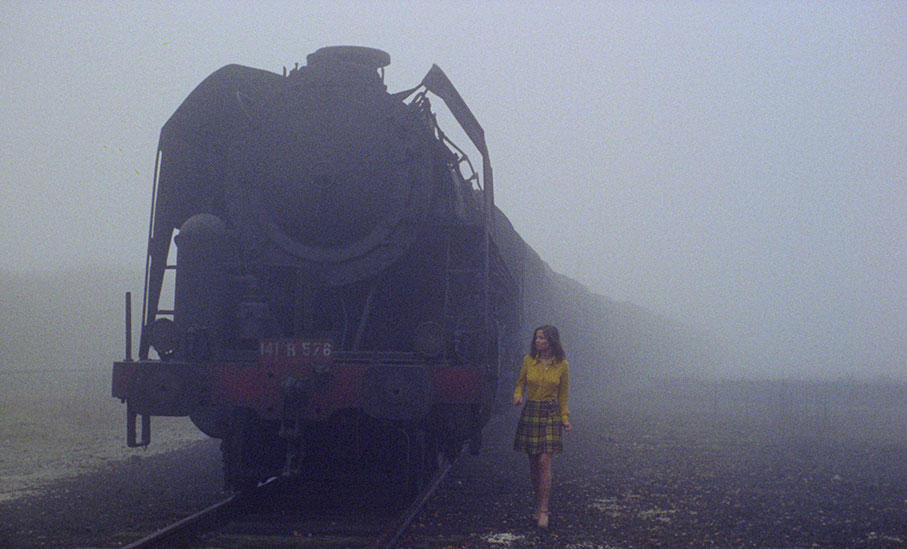
The two meet up the next day in a steam train graveyard and eventually engage in the sort of kissing embrace foretold by the shot that played out under the opening titles. Time then suffers a doubtless time and budget-induced continuity hiccup, with the sun setting as the couple leave the railyard but still well above the horizon when they pause their ride at the iron gates of an old and ill-kept cemetery an unspecified time later. Current day viewers will doubtless widen their eyes in disbelief when they not only leave their bikes unlocked by the roadside outside the cemetery gates when they wander inside, but also that they leave a bag of groceries on the back rack of one of the bikes. They do eventually return for the groceries but elect to leave the bikes where they are, presumably unconcerned that they might be stolen. Times certainly have changed. As they enter the cemetery, they catch glimpses of an old woman (Natalie Perrey) who walks slowly between the larger railed-off graves laying flowers, and a vampire-like figure (Michel Delesalle, who also played the dying bloodsucker in Rollin’s 1972 Requiem for a Vampire), who watches them as he walks through an archway and disappears. Not long later they stumble across a metal hatchway that opens out into an underground crypt below, which the boy opens with the clear intention of entering, playfully daring the girl to do likewise. She’s clearly and understandably apprehensive about doing so, but the appearance of an unpleasantly gruff man (a cameo appearance by Jean Rollin) prompts her to nervously follow the boy down. Here, they strip, embrace and make love by candlelight, and by the time they emerge they discover that night has now fallen. They thus head back in the direction of what they are sure is the main gate but find they cannot locate the path that leads to it, and soon become lost in a cemetery that seems to have no end, whichever way they turn.
Maybe it’s just me, but when trying to choose which disc to review next after my two-week marathon with Laurel and Hardy for Eureka, a brief summary of the above was enough for me to put La Rose de fer at the top of my list. The notion of becoming lost in familiar surroundings, or the mere suggestion that such a location might change its geography when the sun goes down, had me instantly intrigued. What I wasn’t prepared for – and, I suspect, a good many of those coming to this film for the first time will not be either – is what Rollin elects to do with this premise.
It is, I’ll admit, a little too easy to base your expectations for a film on the works for which a filmmaker or lead actor are primarily known. Had the great Bruce Lee lived and made a film with ‘Dragon’ in the title that turned out to be a romantic drama with no fight scenes, for instance, I’m guessing that a sizeable portion of his worldwide fandom would have been up in arms. By this, his fifth feature, Rollin had established himself as a director of erotically tinged vampire movies, and a good many of those who saw La Rose de fer on its initial French release went in expecting it to unfold along similar lines. When it didn’t – and despite the fleeting appearance of that vampire-like figure, it absolutely doesn’t – the film’s commercial and reputational fate was effectively sealed. I’ll admit that I also approached it with similar expectations based purely on the genre films for which Rollin is rightly celebrated, with good reason given his track record in this regard. Where I think I differ from those who reacted so negatively to the film on its release is that instead of disappointing me, it further piqued my interest. If he is not heading down his favoured vampiric route, where, I wondered, could Rollin be going with this? When the answers came, they were so open to interpretation that even three viewings in I’d be reluctant to commit myself to one specific reading.
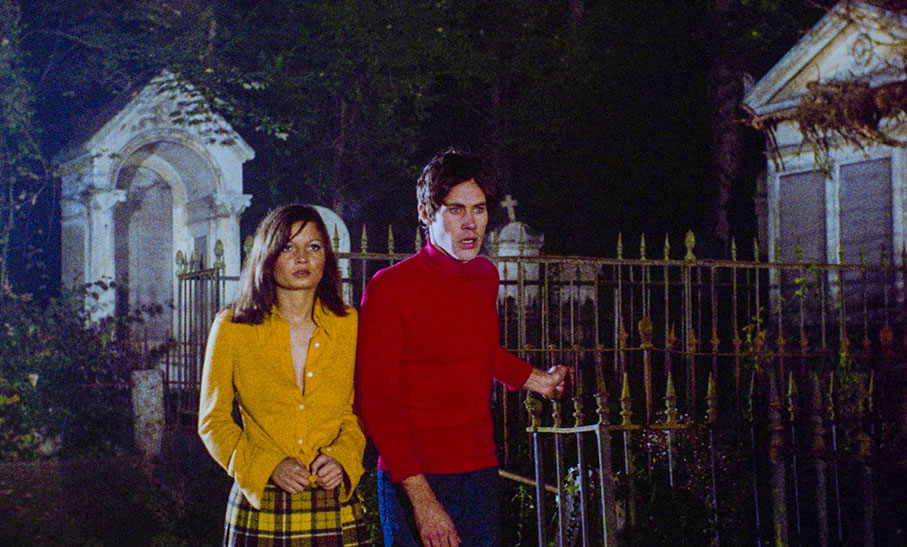
On the surface, at least, we have a large and poorly maintained cemetery that appears to be able to alter its geography in order to trap these two interlopers who have soiled sacred ground by having sex in one of its crypts, otherwise they would surely have been able to simply retrace their steps? Yes, it’s now dark, and yes, they’ve never visited this cemetery before, but still… Yeah, time, I think, for a personal anecdote.
Several years ago, I was cameraman on an independent feature directed by my fellow scribe, Camus (which was another low-budget two-hander, as it happens). One thing we needed to find in the pre-production period was a distinctive tree, one whose shape made it stand out from those around it and that the viewing audience would instantly recognise. After a long day of searching we found what we were looking for, and on the day we were set to shoot at this tree, our director led us all into the dense woodland to the spot where it was located, a journey I had by that point already done with him a couple of times. Not long into the filming itself I realised that I had left some piece of equipment or other back in the car that we had left at a nearby roadside, and as we were taking a break to plan out the next shot, I hiked back to the vehicle and retrieved the item in question. I then headed back into the woods, carefully retracing my steps to make my way back to where my colleagues were doubtless awaiting my return. Except I couldn’t find them. Despite being absolutely certain I had walked the exact same route as before, I soon found myself completely lost, and no matter which direction I headed in or how far I walked, I could not find where I was supposed to be, or even, in these pre-smartphone days, work out where the hell I was. Even worse, I couldn’t find a way out of the woods, which for all I knew stretched on for miles. I was walking for some time in a steadily building panic before I heard the distant voices of children playing and headed in that direction, which ultimately took me to a road that must have been about a kilometre from where I had started out. Fortunately, I picked the right direction to then walk in, and as I spied the car in the distance I realised that our runner had been sent out to try and find me, so long had I been missing by this point. And this was during the day when the sun was up. Imagine how much more disorientating this would have been at night.
For Rollin this proves not to be a mystery to be solved by the intrepid couple but a trigger point for sizeable cracks to develop in their newly formed relationship, which springs in part from their differing and shifting responses to their surroundings. On first entering the cemetery, the boy is unconcerned that they are surrounded by the dead and is even dismissive of the statues and crosses that adorn the graves. “It’s stupid to spend all that money on stiffs,” he says contemptuously as they walk between two lines of towering gravestones. He's even unconcerned about opening the hatch to the crypt and climbing inside, something the girl is not remotely comfortable about doing. When they later emerge, both quickly become nervous when they cannot locate the path to the main gate, and when the girl realises that the boy has tricked her into believing that they have found the outer fence railings, she reacts angrily towards him and runs away. The boy gives chase, and when he catches her his building frustration boils over and he physically assaults her, an attack to which she responds by breaking a wooden cross over his head, leading to a violent physical altercation that leaves both of them battered and exhausted.
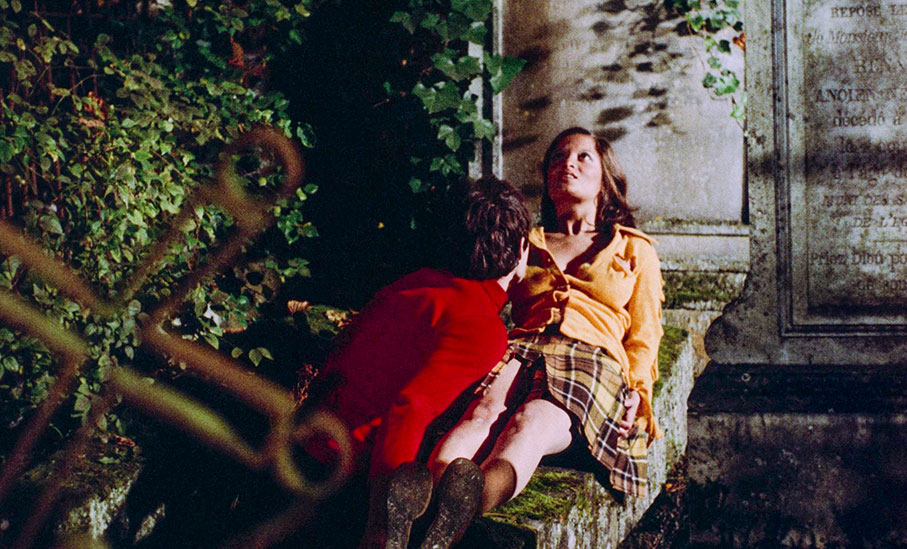
They then seem to settle their differences, but it soon becomes clear that the girl has undergone a personality shift, one that really puts the wind up her increasingly nervous and volatile companion. This first manifests itself when they pause at one of the railed-off gravestones, where the boy sits hunched up, his head resting on one hand and staring ahead with an expression of wound-up frustration. The girl, on the other hand, sits down on a stone sarcophagus, twitching in the manner of someone with a severe nervous disorder, only to then adopt an expression of calm realisation and lie back down on the grave. There, she calmly notes that this is the first of November, a day on which the worlds of the living and the dead intermingle, a statement that causes the boy to jump to his feet in alarm and insist that she stand up, to which she replies with a look of unflustered serenity, “I’m fine here… leave me alone.” This prompts the boy to scream wildly at her, then more calmly try to persuade her that this is not time to give up, only for the girl to almost mechanically sit up with the expression of someone in a hypnotic trance, tremble furiously as if about to explode, and then let out a scream so elongated and piercing that it causes the boy to flee in terror. Frankly, I’d probably have done the same.
The question, of course, is whether this transformation is the result of some supernatural force unleashed by the cemetery and its long-dead occupants or the product of a previously buried psychosis in the girl that a combination of fear, isolation and a sense of hopelessness has somehow awakened. If you’re hoping for a definitive answer you’ll be in for a long wait, as none is forthcoming, leaving the way open for either explanation or even a combination of the two to be the case. What it does do is cause a dramatic shift in the power dynamic, with the previously confident boy now fearful of surroundings that the formerly frightened girl is now perfectly comfortable with, to the point where she appears to have formed an empathic bond with the deceased.
Traditional storytelling has no real place here, and is only included at all to bring the couple together and transport them to the cemetery and into the underground crypt, from which point on it becomes all about the location, the ethereal atmosphere, and the breakdown in communication and crumbling mental state of the two leads. Of all the Rollin films I’ve now seen, this feels the most personal, one that breaks not just with the conventions of narrative cinema but the films with which he is still most associated. There is no vampirism, no bloodletting, and the relationship at its centre is a male/female one rather than the usual young female couple. Even the film’s two sex scenes are shot in a visually chaste manner, to the point where it’s quite possible to question whether any coupling actually takes place in either. Nudity is also restricted here to a single scene in which the girl seems to peer into an alternate dimension, visualising herself naked on the Dieppe beach of the opening scene, where she is filmed in wide shot and the image is heavily filtered, effectively quelling its erotic potential.
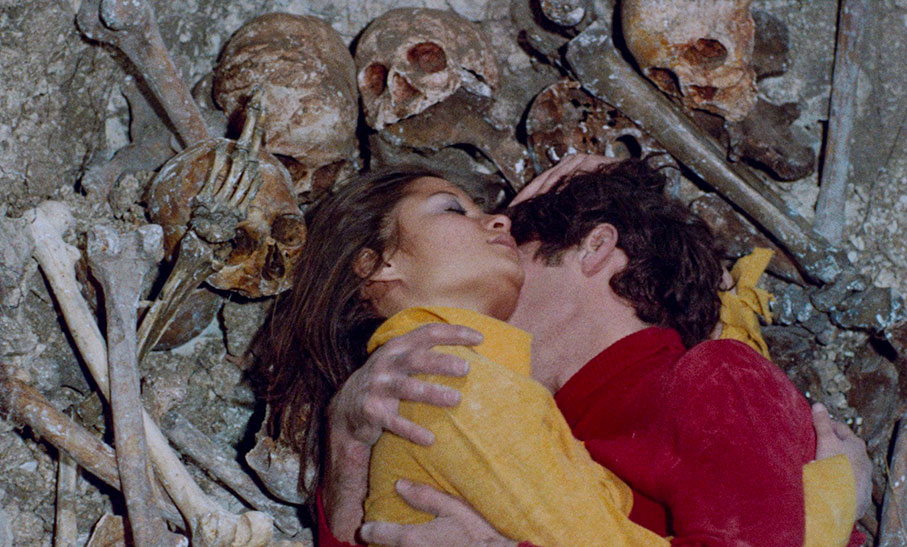
What is retained from Rollin’s previous films is their poetic surrealism, which manifests itself here in a variety of ways: the almost loving vocal embracement of death and the afterlife that accompanies the girl’s vision of herself on the beach, which is peppered with iron graveyard crosses; the rotating POV shots as the girl looks down into the excavated pit into which the boy has fallen, in which they then make love amongst the bones of the dead; the human skull that the girl holds in front of her face, transforming her into a gothic image of death and seriously disturbing her companion; the cutaways to gravestone statues and stone cherubs that give the impression that they are observing the couple’s every move; the sad-looking clown (Mireille Dargent, who played one of the initially clown-dressed girls in Rollin’s previous film, Requiem for a Vampire) in full costume and makeup who walks slowly through the cemetery to lay flowers on an ancient grave; the girl’s late-film dance through the cemetery, which although added as filler to punch up the running time to feature length is still dreamily executed and handsomely shot, and plays like an appropriate development of the girl’s drift into a form of contented madness. Crucial to making this work is François Pascal’s finely judged performance as the girl, required as she is to make a sometimes staccato transition from a nervous young woman to someone who is either possessed or is rapidly losing her mind, something she pulls off with most convincing aplomb. Sound also plays an important role, from the pre-Lynch industrial railroad clanking in a train yard that is devoid of human activity to the clanking of bones as the couple make love in the excavated pit, and the haunting strains of Pierre Raph’s sparsely used but eerily evocative score.
That the film failed to find an audience on its initial cinema release is, in retrospect, not that surprising, and it still has the potential to divide an audience today, even one normally sympathetic to Rollin’s cinema. If you’re looking for evidence, check out the comments on the film’s IMDb page, where it is described by one viewer as “a minimalist, lyrical, unusual and disorienting beautiful ode to Death,” and another as “visually overwhelming but insufferably boring Rollin-nonsense.” On my first viewing, I was certainly unsure how I felt about what I had just seen, despite my intrigue at both the premise and the setup, and the fact that I never felt bored or frustrated by the film that subsequently unfolded. The second time around, however, it all really clicked for me, to the point where it was only a matter of hours before I felt the urge to watch it a third time. Having also been captivated by Rollin’s later The Night of the Hunted (La nuit des traquées, 1980) and The Escapees (Les paumées du petit matin, 1982), two other films that play creative and unexpected games with the established Rollin formula, I was perhaps already prepped for what in some ways is his most experimental feature. It was after those second and third viewings that I better understood the passion that Stephen Thrower expresses for the film in the special features, and may well explain why I’ve ultimately had to cut myself short to avoid spending the next week or so expanding on what I’ve written above, which honestly just scrapes the surface of what I feel could be said about the film. Not everyone will agree, and I totally get that, but something about this strange, haunting, intermittently surrealistic ode to the dead spoke to me on a very personal level, one I’m perhaps not completely at ease with at my age but that I nonetheless feel emotionally and philosophically enriched by.
To quote the accompanying booklet:
“The Iron Rose was scanned, restored and colour corrected in 4K HDR at Renasci Films, using the original 35mm negative. Many thousands of instances of dirt were removed, scratches, stains and other imperfections eliminated, and a number of damaged frames repaired. No grain management, edge enhancement or sharpening tools were employed to artificially alter the image of [the] film in any way.”
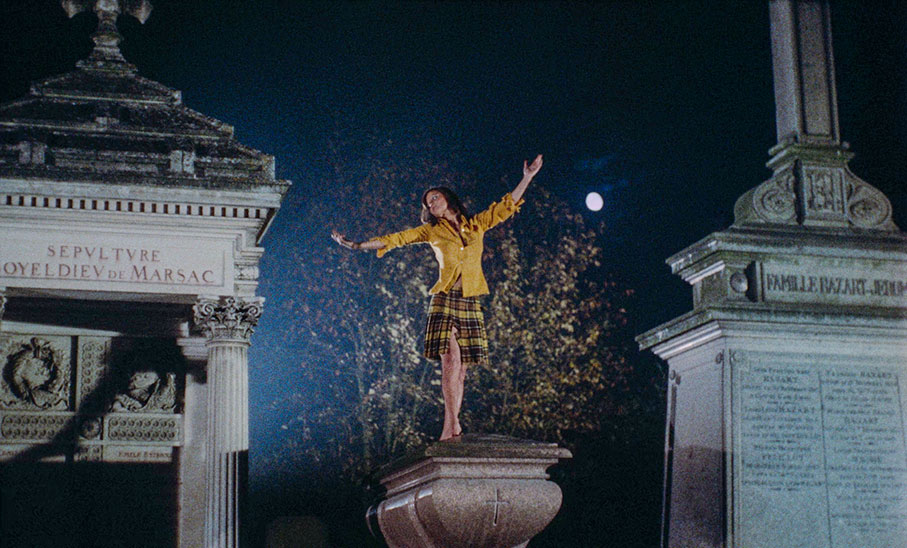
The results are absolutely on a par with previous Indicator releases of Rollin films, with clearly defined detail, rich reproduction of brighter colours, and well balanced contrast with appropriately deep black levels, especially important when night falls on the cemetery. Having access to both the Blu-ray and UHD releases of the film I was once again able to compare the two, and was surprised how closely they resemble each other, which I’m putting down in part to what I’m assuming was the use of high speed film stock to more easily facilitate shooting in low light, stock that back then tended to have coarser film grain and slightly less finesse on fine detail definition as a result. Oddly enough, it’s the clarity of the grain on the UHD that most obviously differentiates it from the Blu-ray, with the lower resolution of the Blu-ray having a slightly blurring effect on it. Look closely at the detail, however, particularly the patterns on clothing and the graveyard textures, and they are often just that bit clearer and crisper on the UHD, and the Dolby Vision HDR does result in a subtle increase in the depth and vibrance of the colour. Both transfers are clean and stable in frame, and while the UHD definitely has the edge, if you’ve not yet made the upgrade to 4K you’ll have no complaints with the Blu-ray.
The original mono soundtrack is presented on both discs in DTS-HD Master Audio 1.0, and despite a very faint level of background hiss and the inevitable restrictions in tonal range that can make louder sounds seem just a tad shrill, the dialogue, music and effects are all clearly presented, important for a film in which sound plays such a crucial role.
Optional English subtitles are activated by default, but can be switched off on the main menu or on the fly via the remote if your French is up to the task.
Audio Commentary with Tim Lucas
Film expert and author Tim Lucas is something of a regular when it comes to commentaries on Indicator releases of Jean Rollin films, and he once again delivers a fascinating blend of factual information and in-depth analysis, something that The Iron Rose lends itself perfectly to. Lucas does get creative with that analysis here, yet every time I found myself whispering “Oh, come on…”, I soon found myself being persuaded by the merits of his arguments. We get information on the locations (particularly the cemetery in which the majority of the film is set), editor Michel Patient, poet Tristan Corbière, and both of the lead actors, including the behaviour that put male lead Hugues Quester at odds with Rollin, to the point that they eventually had to communicate through an intermediary. Lucas discusses a few key genre films that have made inventive and effective use of cemetery settings, recalls when he first became aware of Rollin’s films through an article in Cinefantastique (for which he also wrote), and talks about the death drive and how it manifests itself in the behaviour of the two leads. It’s here that I learned that the late film dance through the cemetery was improvised by Rollin and Françoise Pascal to pad out the film to feature length, and I love Lucas’s suggestion that the film is “made up of a collection of loose scenes floating in a soup of memory.” This is just a sampling of a densely packed and compelling listen.

Jean Rollin Introduces The Iron Rose (1:14)
A brief introduction to the film by Rollin in the style of the ones on previous Indicator releases (Rollin reclining on a sofa and speaking in English with a masked figure sat motionless by his side, who this time is holding a rose over one eye). He describes La Rose de fer as his strangest film, draws parallels with his previous film, Requiem for a Vampire, and reveals that the idea behind it was to shoot a film with only two main characters. If the above cited running time seems short, know that Rollin only speaks for 38 seconds of that – the rest is devoted to film extracts and a short final credit role for cameraman and editor Daniel Gouyette, a name that Rollin fans will be familiar with by now and that you’ll be seeing again in the special features here.
Jean Rollin: Cemetery Gates (3:39)
A brief interview with Jean Rollin, shot for the 2005 Redemption DVD release of the film, in which he talks about the Cimetière de la Madeleine setting, the exhausting all-night shoots, how the film wildly divided opinion, and how its reputation has shifted over time.
Les Nuits du cimetière (15:51)
Another in the series of retrospective documentaries by Rollin’s personal assistant, Daniel Gouyette, this one is focussed exclusively on La Rose de fer and built around interviews with regular Rollin collaborators Natalie Perrey and Jean-Noël Delamarre, and film journalist Alain Petit. The lion’s share of the screen time is devoted to Perrey, who served as the film’s script supervisor and a good deal more, as well as playing a small but memorable supporting role as the old woman who lays flowers on the graves. She recalls feeling that the film was a true Rollin piece as soon as she read the script, and that the unexpected arrival of thick fog made it feel as if the gods were on their side, even to “the godless anarchists amongst us.” She reflects on how news of the death of R.J. Chauffard – to whom the film is dedicated – affected the mood of the shoot and was channelled into her performance, and confirms claims made elsewhere that everyone involved was happy to be part of the project except for lead actor Hugues Quester. Delamarre reveals that they obtained permission to shoot in the cemetery by claiming to be making a documentary about it, which meant pretending to shoot beauty shots with an empty camera when the set was visited by the local mayor. Petit, meanwhile, recalls seeing the film at a private viewing and liking it enough to include in a festival programme, a screening that he describes as a disaster and that Perrey equates to the Battle of Hernani. Usefully, Petit does provide some background detail on what led to the festival audience so vocally mocking the film.
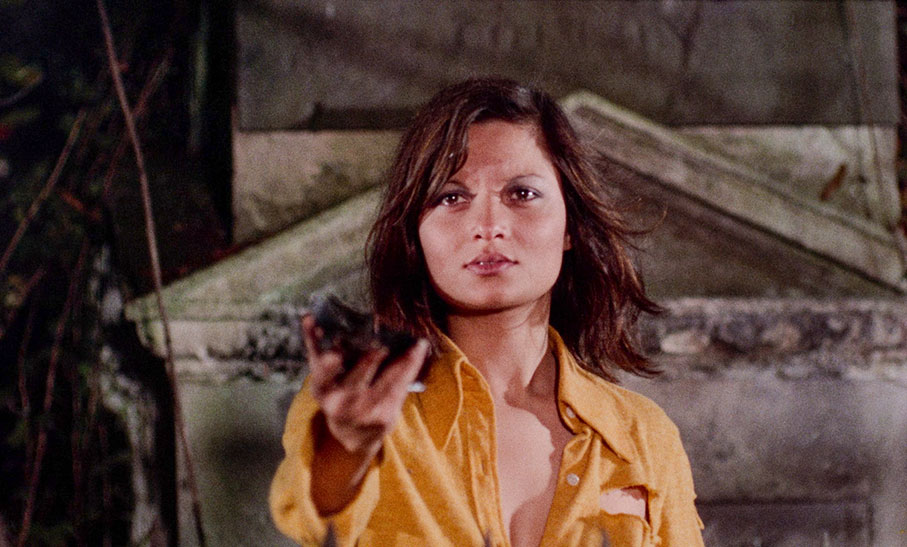
Archival Interview with Françoise Pascal (22:03)
An interview with actress François Pascal, shot for Salvation Films in 2012 and conducted in English, in which the Mauritius born, UK resident actor is unsurprisingly fluent. She recounts how she was introduced to La Rose de fer by Rollin’s regular producer, Sam Selsky (whom she describes as a lovely man and like a father to her), admits to never having heard of Jean Rollin before then, and to learning scenes that Rollin would then frustratingly cancel the shooting of without warning. She recalls it being close to freezing when they shot the nude beach scene, that she turned down an offer from Kirk Douglas to appear in the 1973 Scalawag to do Rollin’s film, and that cinematographer Jean-Jacques would bring a case of wine to the set for everyone to drink while they shouted for Jules Verne (who is buried in the Cimetière de la Madeleine) to protect them during the night’s shoot. She looks back at the film as a magical experience, but confirms that her co-star Hugues Quester was difficult to work with, noting that he didn’t like Rollin and that he took his frustrations out on her in the scenes of physical conflict. There’s so much more of real interest here, including a touching story of planned reunion with Rollin that never took place due to the filmmaker’s passing, and an amusing story about attending a screening of the film with a former boyfriend.
Françoise Pascal: Woman is Free (23:49)
A French language interview with Françoise Pascal from 2018 that takes us on a film-by-film trip through her movie career, right up to La Rose de fer, whose ultimate prominence is foreshadowed by the interview being conducted in the Cimetière du Père Lachaise in Paris with Pascal holding what looks like an iron rose. Her recollections are always worth hearing, and there are some interesting and revealing comments made here. I’d question the morality of the producer on Norman J. Warren’s Loving Feeling (1968), who convinced the then 17-year-old Pascal to do a semi-nude scene that she wasn’t comfortable with by taking her to the pub and plying her with brandy, an indication of how times have (hopefully) changed. She followed this with a small role in the Rolling Stones docudrama One + One (aka Sympathy for the Devil) for director Jean-Luc Godard, whom she describes as strange and recalls him writing the script as he went along, intermittently pausing filming every time he had a new idea. We’re left to speculate on what was behind her refusal to talk about Pete Walker’s 1969 School for Sex – “I won’t talk about Pete Walker or about that film,” she states with some venom, “I hate that film and I hate Pete Walker. And everybody knows that. The first director I can’t stand.” Conversely, she loved working with Peter Sellers on There’s a Girl in My Soup (1970) and Soft Beds, Hard Battles (1974). “I adored Peter,” she tells us. “He was my friend. He taught me a lot about comedy,” advice she later put into practice in the now dated ITV comedy series, Mind Your Language. She talks about her long-term relationship with actor Richard Johnson, with whom she had a son, and intriguingly says of their post-separation period, “We were good friends… until I wrote my book. After my book was released, I was no longer his friend.” I have a feeling I need to read that. Her three disco records are briefly discussed (one of which provides this interview with its title), as is the artistic nude shoot she did for the first issue of Penthouse magazine to be published in America. There’s plenty of time given over to her work on La Rose de fer, and while much of this is also covered elsewhere in the special features, there is some information unique to this interview, and her claim that she doesn’t have anything wonderful in her film resume except La Rose de fer says a lot about her fondness of the film and for Jean Rollin.
Françoise Pascal: Kiss From a Rose (2:31)
A brief montage of shots, filmed by Christian Valor for the website Psychovision and set to music, of a signing session by Françoise Pascal at the Metaluna store in Paris on 7 April 2018, at which key Rollin collaborators Jean-Pierre Bouyxou, Jean-Noël Delamarre and Serge Rolling were also present.
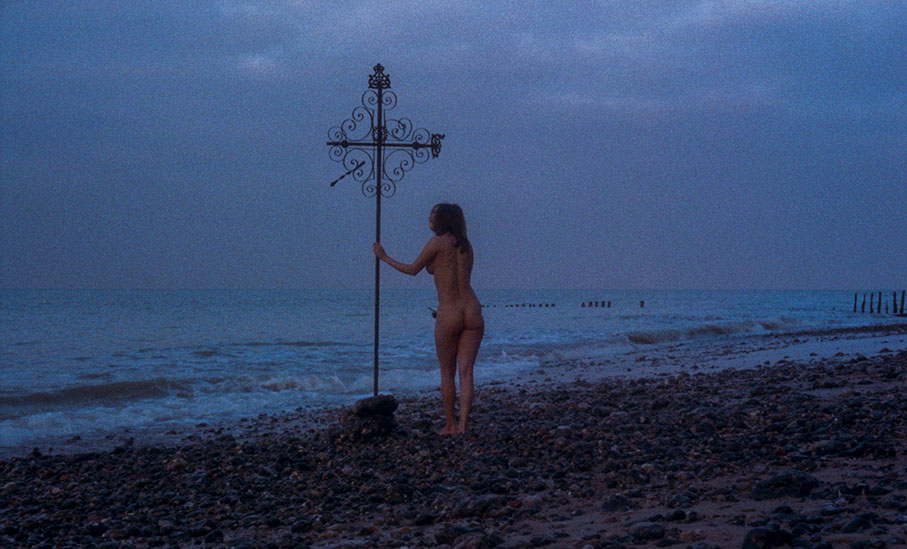
Stephen Thrower: Children of the Grave (30:42)
Hugely knowledgeable film scholar and author Stephen Thrower provides a concise outline of Jean Rollin’s early years and film work in a lead up to a detailed look at La Rose de fer. It’s a film that Thrower makes no secret of his love for, stating that, “Any Goth in the world who hasn’t seen La Rose de fer really needs to watch it right now because this is one of the most purely beautiful, perfectly realised gothic fantasies I think ever put on film.” Thrower is a perceptive analysist who always explains his reasoning clearly, boldly providing a definition of what constitutes poetry and then outlining the ways in which that definition has to be rethought when applied to Rollin’s work. He examines a single scene in detail to illustrate his claims about the impact of the imagery, notes that the film strips away many conventionally important elements to focus on the textural beauty and serenity of the graveyard, attempts to pinpoint when it is that events takes a darker turn, and acknowledges that a potential pitfall of such a work is that the audience is invited to decode elements that ultimately do not need decoding at all. This is just a sampling from a rich and fascinating look at the film and its creator.
Four Trailers have been included, all with a running time of precisely three minutes and 42 seconds. Quite a coincidence, huh? Well, not exactly, as the film content of all four is identical, and the only thing that differs is the title graphics. In French Theatrical Trailer #1, the title is LA ROSE DE FER, which is written in magenta capitals with the ‘O’ of ‘Rose’ replaced by a graphical rose. French Theatrical Trailer #2 is the exact same trailer but with “OU LA NUIT DU CEMETIERE” in white lettering and a different font tacked on beneath the original title. International Theatrical Trailer #1 is essentially the first French trailer but with title changed to its alternative English title, THE CRYSTAL ROSE in the same font and colour as the French title with the same rose graphic. International Theatrical Trailer #2 reproduces the second French trailer with “OR THE NIGHT OF THE CEMETERY” added beneath the main title in white capitals in the same mismatched font as the French original. The trailer itself is interesting, opting to exclude almost all dialogue and include creepier elements of Pierre Raph’s score to give a flavour of the film’s otherworldly atmosphere, and using clips that suggest the breakdown of the relationship between the two leads and the drift towards madness without being explicit about either. That said, the decision to place the couple’s romantic engagement in the railway graveyard in the daylight hours close to the end does seem designed to suggest it will all end happily, a perception seconded by the tagline, “A strange love story.”
There are four Image Galleries. Original Promotional Material has 39 screens featuring promotional stills of varying quality, and scans of VHS video covers, press book pages and posters. Behind the Scenes runs for 46 screens, and includes monochrome pictures of Rollin and his collaborators at work on the shoot, a few of a birthday party thrown for Françoise Pascal at the hotel at which they were staying, three of an unidentified child pasting a poster for the film on a wall of posters, a colour one of Rollin standing on a seaside fence railing next to a billboard poster for the film, and six colour shots of Pascal posing with the iron rose of the title. Dialogue Continuity Script is very much as the title says, consisting of 17 screens with two typed script pages per screen. Unsurprisingly, the dialogue often differs from how it plays in the film, a comparison that is made easier for us non-French speakers by this being the “version anglaise.” Finally, we have ‘La Nuit du cimetière’ Prose Treatment, a scan of Rollin’s original short story, La nuit du cimetière, as it appeared in the May 1972 edition of L’Impossible magazine. This time you will need to be proficient in French to read it.

The Yellow Loves (Les Amours jaunes, 1958) (10:38)
Jean Rollin’s first solo film venture, which was shot on 35mm when he was just 20 years old, is inspired by the work of poet Tristan Corbière, being a visual interpretation of extracts from his works, The Yellow Rose and Aurora. I’ll admit to not being much of a written poetry guy, so am in no position to deconstruct Corbière’s prose, beyond noting that it appears to be about a poet who lives an isolated life and writes primarily because “he didn’t know how to die,” and that Rollin’s imagery goes its own way with the spoken words. Set on the Plage de Dieppe beach that would become a signature element in Rollin’s cinema, it depicts what we can presume is the lone poet of the verse as he attempts to befriend two young children, who quickly run away (always a wise move, kids), despite being curious about what the poet then draws in the sand. Meanwhile, a solitary woman that I initially, and mistakenly, assumed was the children’s mother, walks slowly and distractedly along the shoreline. Then, six minutes in, live action unexpectedly switches to a series of Picasso-esque drawings of distorted and sometimes intermingled or animal-hybrid humans, before returning to live action and more animated camera shots of a docked fishing vessel as the narrator (Rollin’s actor father, Claude Louis René Rollin-Roth-Le Gentil, aka Claude Martin) comes close to bellowing lines from Aurora, before we return to the lone poet on his beach. An intriguing experimental work made at the very cusp of the Nouvelle Vague that prefigures the avant-garde undertones underpinning many of Rollin’s later commercial works.
The booklet states that The Yellow Loves was scanned, restored and colour corrected (yes, it’s a monochrome film, but that’s the technical term whatever the source material) in 4K HDR at Filmfinity, using the original 35mm negative. While there are some faint traces of wear just visible on the white of cloudy skies, this has also been impressively cleaned up and stabilised and looks very good here.
The film can also be played with commentary by Tim Lucas, who, perhaps wisely, does not attempt to deconstruct or interpret a work that he describes as being inscrutable even today, noting also that it must have been even more so when it was first shown back in 1958. Instead he outlines how Rollin began his career at the age of 16 working for a film company, and how his interest in cameras ultimately led to him borrowing one to make this film. He also reveals that he spent his military service working in the film department alongside future director of note Claude Lelouch, he of A Man and a Woman (Un homme et une femme,1966), Bolero (Les uns et les autres, 1981) and Les Misérables (1995). He profiles poet Tristan Corbière and identifies the two works the film’s narration is sourced from, reveals that the artwork featured was the work of actor Fabien Loris, and finds connections between this film and Rollin’s later work, particularly La Rose de fer, hence its inclusion on this disc.
Booklet
A densely-packed 76-page booklet whose lead essay is by Cincinnati-born, Brooklyn-based writer focused on moving-image-based art, Nick Pinkerton, who delivers an arresting scene-by-scene analysis of the film and its creator. This is followed by an introduction to the film written in 1997 by Jean Rollin, who describes it as his greatest commercial failure and a continuation of his pursuit of simplification, before reflecting on the casting of the two main actors and the shoot itself – it’s also well worth reading the footnotes that accompany this. What we have next is an unexpected plus, an English translation of the Rollin penned scenario La Nuit du Cimetière as it was published in L’Impossible magazine, allowing us non-fluent French speakers to compare the source material with the film that it ultimately gave birth to. We then have an interview with Françoise Pascal conducted in 2015 by Joe Young, who usefully asks Pascal primarily about her work on films that were not covered in the filmed Woman is Free interview, although there is some inevitable discussion of The Iron Rose. As ever, Pascal’s responses are of real interest – I was particularly taken by her repeated regret that she never got to work on a Hammer production. An introduction by Jean Rollin to The Yellow Loves is focussed primarily on the process of making his first short film, and is followed by a brief but welcome piece on poet Tristan Corbière by Katherine Lunn-Rockliffe from the 2018 Oysters, nightingales and cooking pots: Selected poetry and press in translation. Details of the restoration and full credits for the film are provided, and the booklet, as ever, is well presented and nicely illustrated with promotional and behind-the-scenes imagery.
The favourite phrase “not for everyone” goes double for a film that even Jean Rollin describes as his strangest, but despite some initial uncertainty I became utterly seduced by this oddly mesmerising and hauntingly realised work. The restoration and transfer are both up to the expected standard, and are backed by a high number of quality special features. For fans of this distinctive filmmaker’s work who are willing to go where he takes you, even if he breaks with convention and expectation, Indicator’s excellent UHD and Blu-ray releases are both easy and enthusiastic recommendations.
|